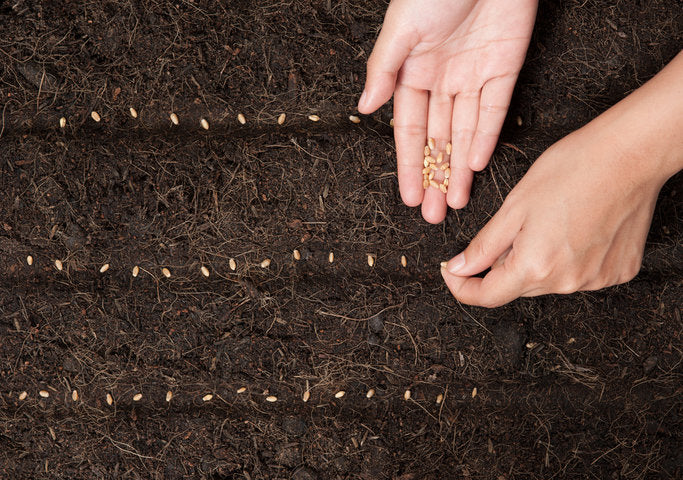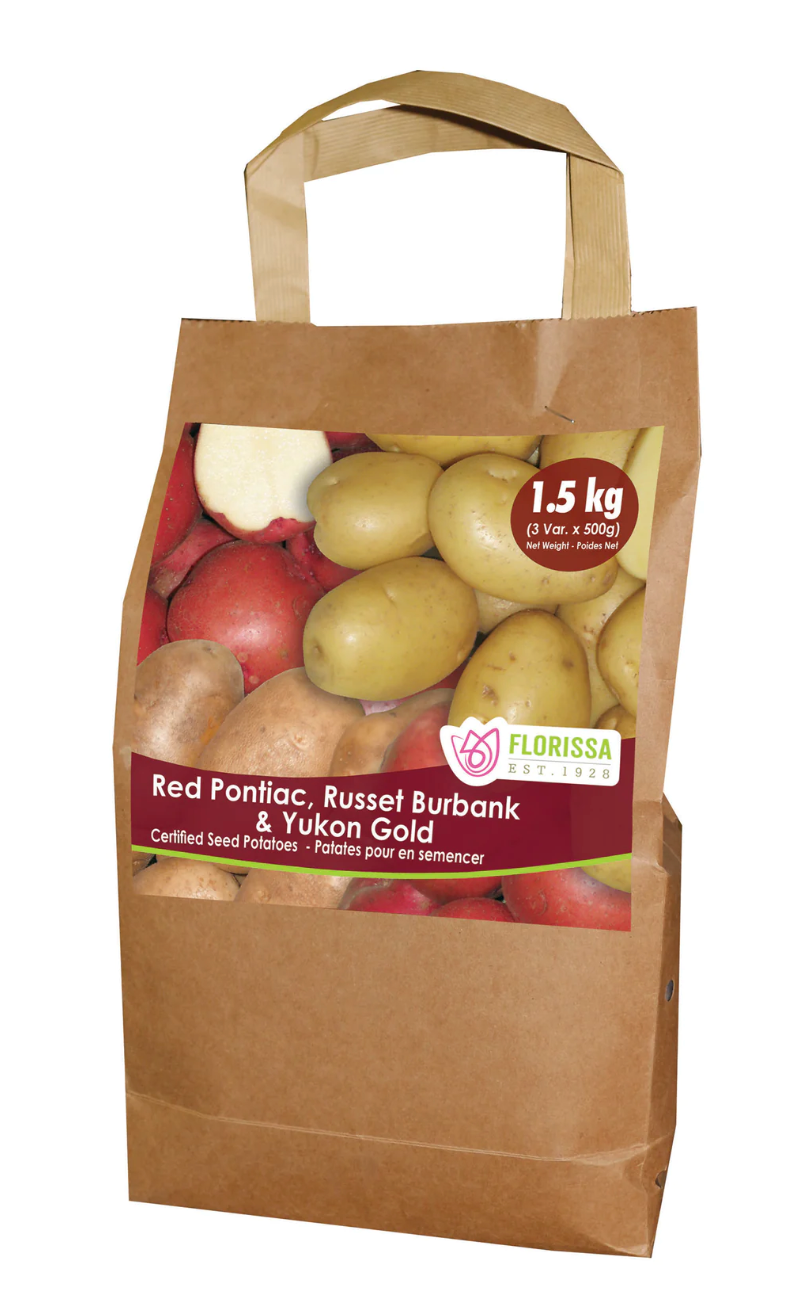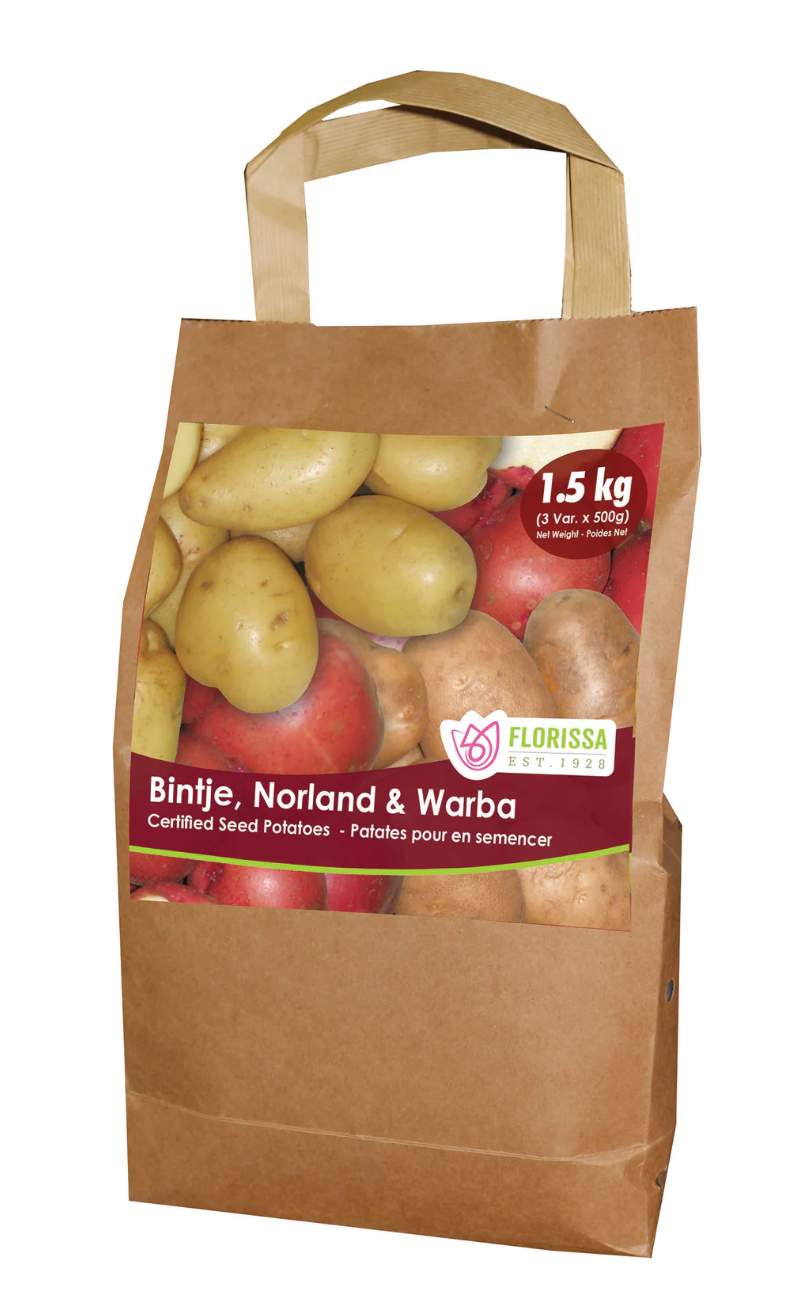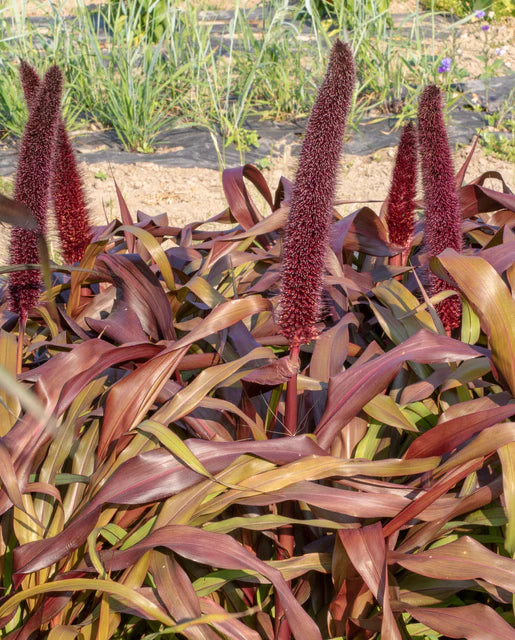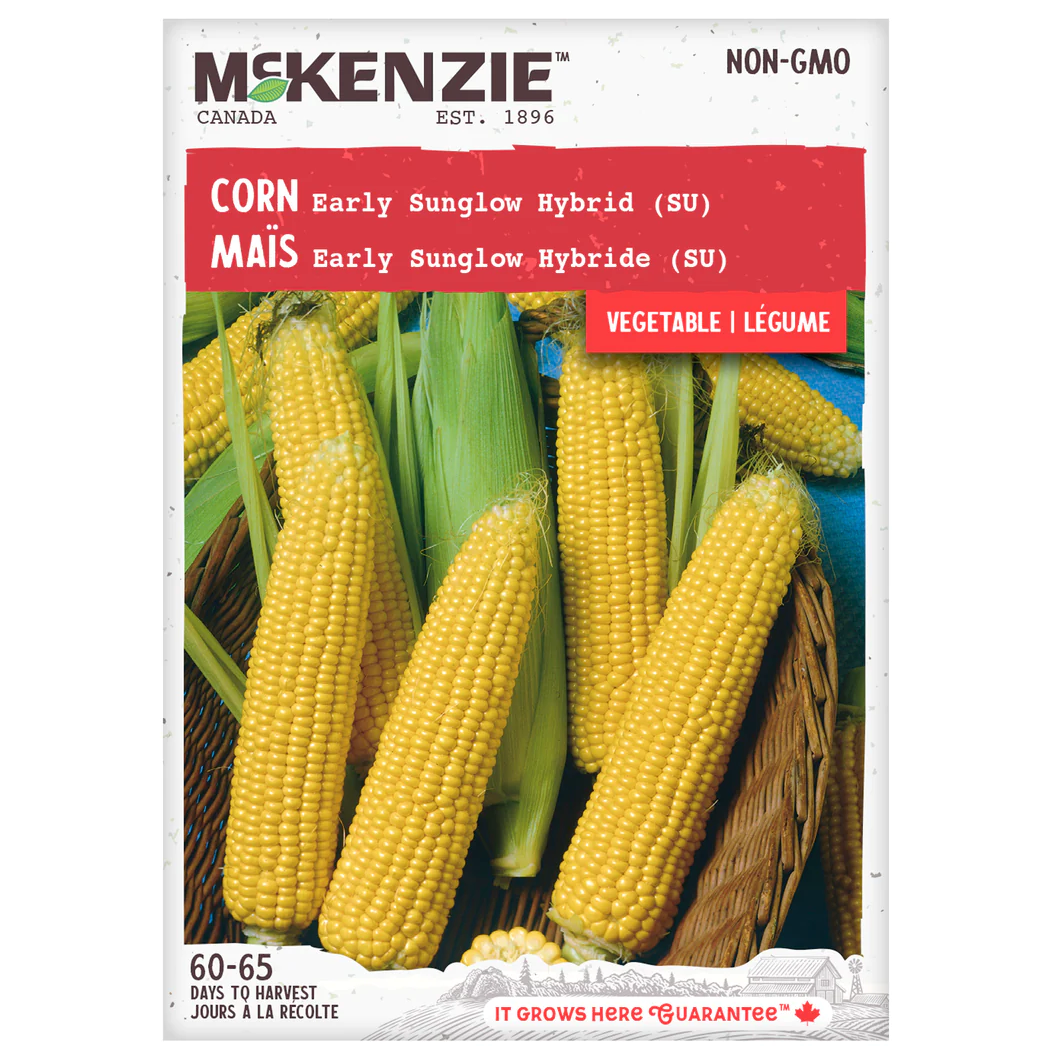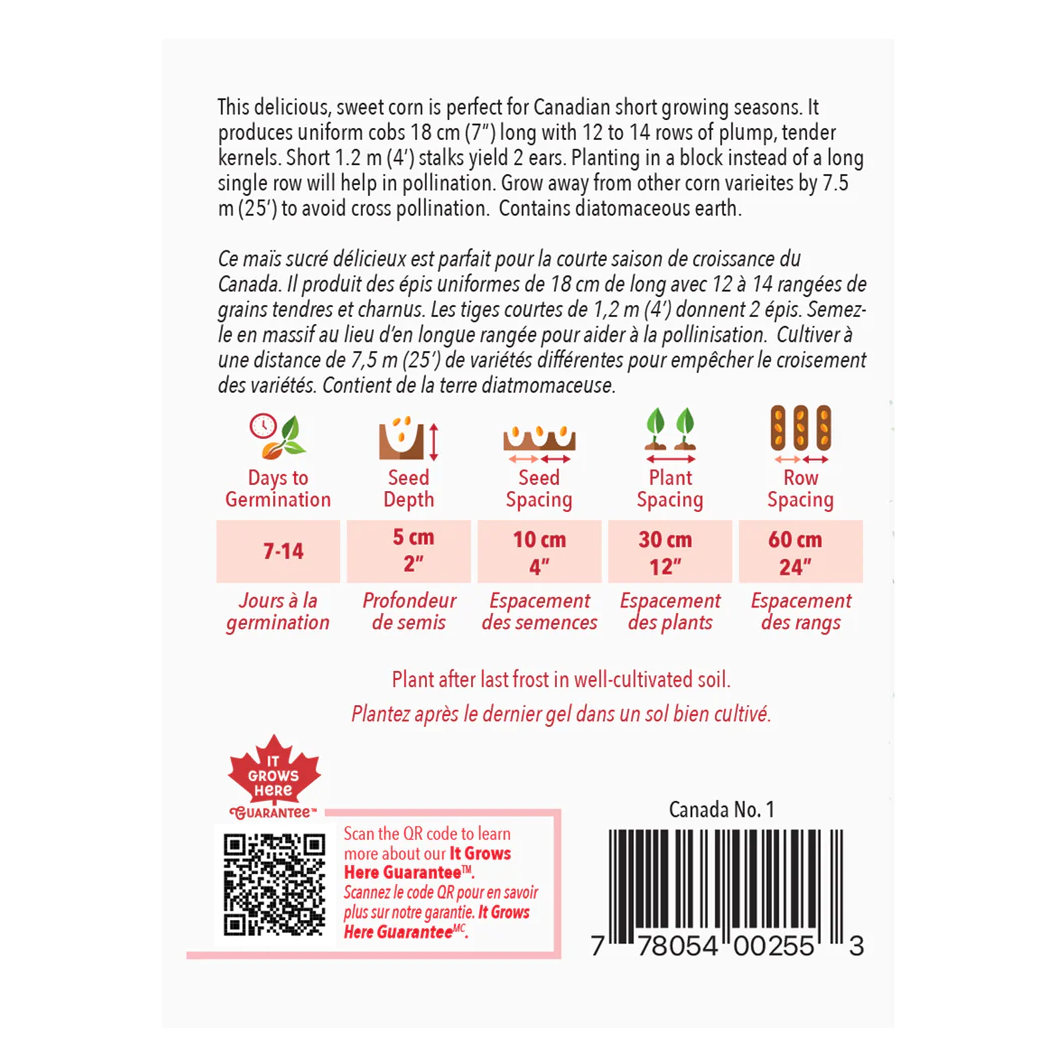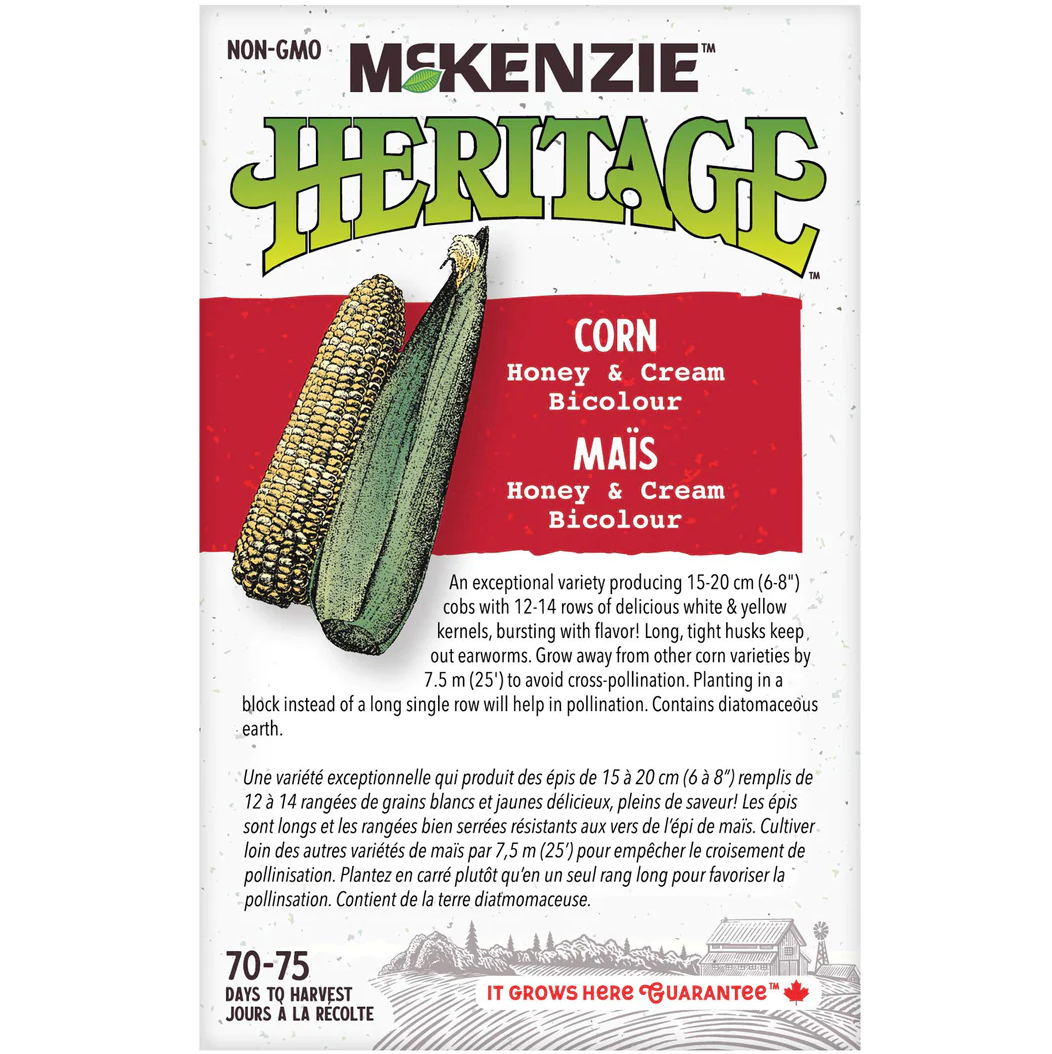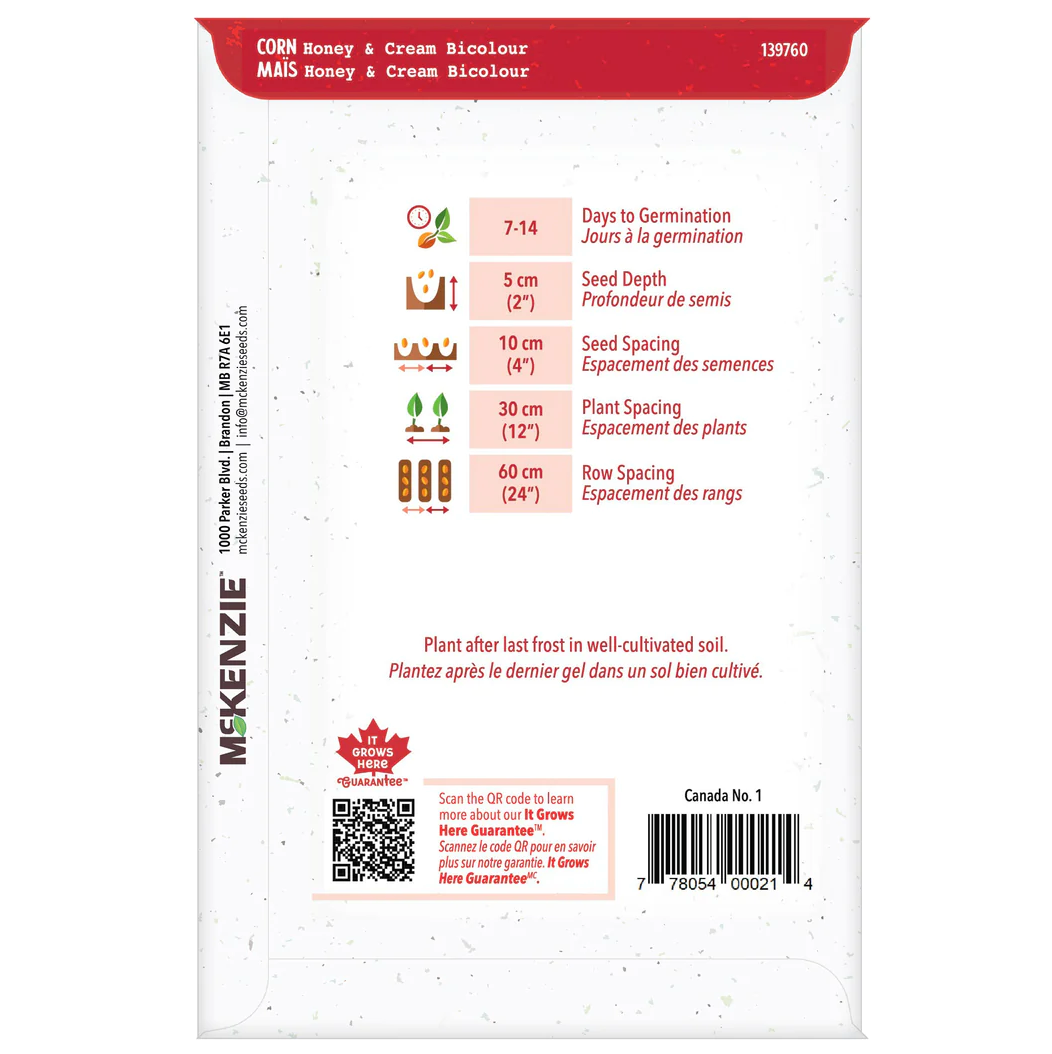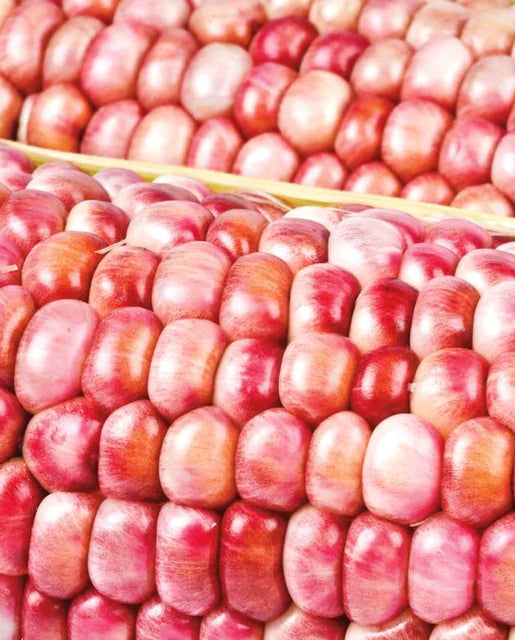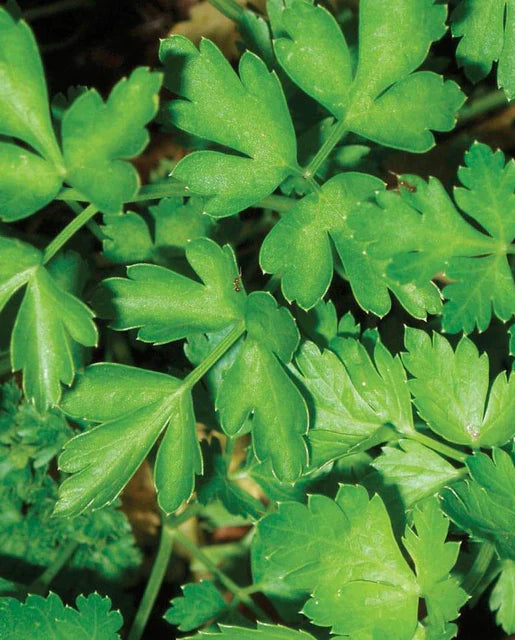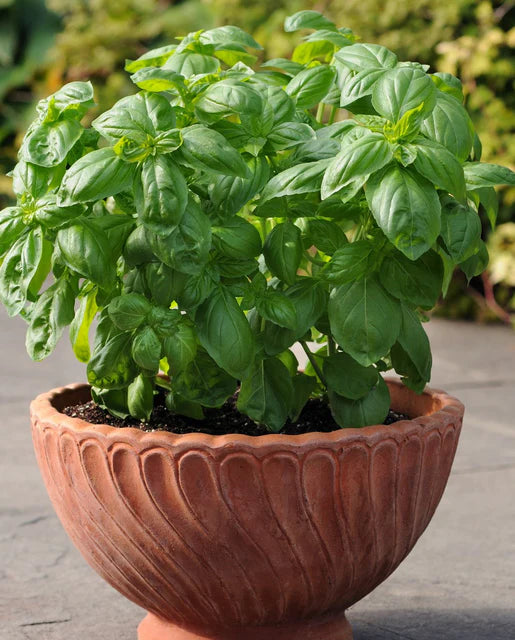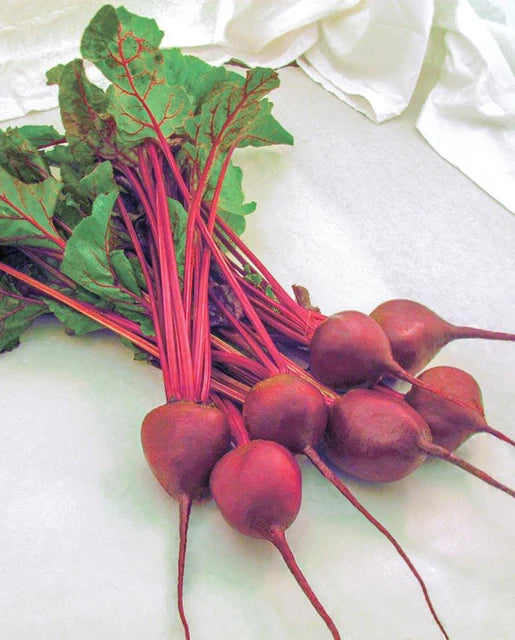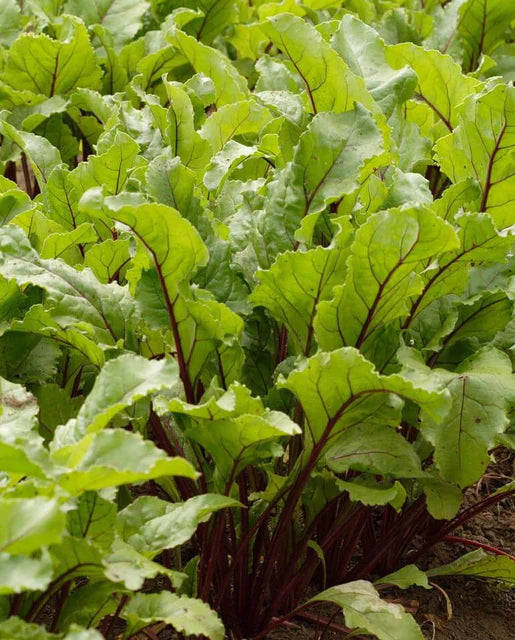309 products
309 products
Sort by:
Seeds
This is a blend of green and red lettuces selected for use as baby greens. These lettuces look spectacular in a container with their diverse shapes, colours, and textures, almost like a bouquet of flowers. Harvest the baby greens with scissors for an instant, pre-mixed salad. Grow in full sun from fall to spring, and in partial shade in the summer. Each pellet contains numerous seeds, so one or two pellets per 5" container is ample. The result is very attractive and fully edible.
Matures in 55 days. (Open-pollinated seeds)
- Babyleaf
- Blend of green and red lettuces selected for baby greens
- Diverse shapes, colours and textures
- Blend of green and red lettuces selected for baby greens
- Open pollinated seeds
- Matures in 55 days
Plant in a block or in a wide row. Sprinkle the seeds evenly over prepared, moist soil. Try to space seeds about 1cm (½”) apart. Cover lightly with soil, and firm them in. Four grams of seed will plant a 12m (40′) row that is 7cm (3″) wide, so don’t plant the whole packet at once. For container growing, choose containers that are at least 10cm (4″) deep. Wider is better. The most common mistake is over-planting.
Our tallest, darkest romaine, Coastal Star Organic performs brilliantly in spring and fall, and even in winter with some protection from hard frost. This romaine is early maturing with a high resistance to corky root. Heads are tightly packed around blanched tender hearts, and have an overall pleasant lettuce flavour. Growth is very upright on plants that average around 30cm (12″) tall. Even the outer wrapper leaves are held off the ground, so there no bottom rot issues. The dark colour of Coastal Star is thought to represent a more nutritious lettuce than the paler romaines like Plato II.
Matures in 65 days. (Open-pollinated seeds)
- Certified organic seeds
- Huge romaine heads
- Great disease resistance
- Matures in 65 days
Direct sow or start indoors and transplant. Sow seeds 5mm (¼”) deep, or on the surface of the soil where the soil can be kept evenly moist.. Space or thin heading lettuce to 30cm (12″) apart. Space or thin looseleaf varieties to 20-25cm (8-10″) apart. Space rows for all types 45-90cm (18-36″) apart. Babyleaf lettuce can be planted quite densely, as it is harvested at an immature size. Sowing babyleaf lettuce seeds closely together in narrow rows makes harvesting simpler.
Coastal Star Organic romaine lettuce seeds are CERTIFIED ORGANIC! Our tallest, darkest romaine, Coastal Star performs brilliantly in spring and fall, and even in winter with some protection from hard frost. This romaine is early maturing with a high resistance to corky root. Heads are tightly packed around blanched tender hearts, and have an overall pleasant lettuce flavour. Growth is very upright on plants that average around 30cm (12") tall. Even the outer wrapper leaves are held off the ground, so there no bottom rot issues. The dark colour of Coastal Star is thought to represent a more nutritious lettuce than the paler romaines like Plato II. Pelleted seeds.
Matures in 65 days. (Open-pollinated seeds)
- Pelleted seeds
- Certified Organic
- Early maturing
- Our tallest romaine
Direct sow or start indoors and transplant. Sow seeds 5mm (¼”) deep, or on the surface of the soil where the soil can be kept evenly moist.. Space or thin heading lettuce to 30cm (12″) apart. Space or thin looseleaf varieties to 20-25cm (8-10″) apart. Space rows for all types 45-90cm (18-36″) apart. Babyleaf lettuce can be planted quite densely, as it is harvested at an immature size. Sowing babyleaf lettuce seeds closely together in narrow rows makes harvesting simpler.
SUMMER HARVEST. Copenhagen Market cabbage seeds are a Danish heirloom introduced by H. Hartman & Co. in 1909. This early variety forms round, solid heads 15-20cm (6-8") in diameter, making it the largest early round-head cabbage for summer harvest. This summer harvest variety has good keeping ability, excellent uniformity, and rich flavour. This variety is outstanding for coleslaw. It's a popular market variety that has the added benefit of shipping very well. Protect your cabbage row from the caterpillar of the cabbage moth by draping lightweight row cover over the plants.
Matures in 63 to 100 days. (Open-pollinated seeds)
When learning how to grow cabbage, sow 3 or 4 seeds per pot, 5mm (¼”) deep, under very bright light. Thin to the strongest plant. Space transplants 45-60cm (18-24″) apart in rows 60-90cm (24-36″) apart.
Pennisetum glaucum. With its cousins Purple Majesty and Jade Princess, Copper Prince Millet is the very picture of ornamental grass. The golden green foliage darkens at the points most exposed to the sun, becoming more mahogany in tone. About mid summer, the rush-like panicles begin to emerge, rising to a height of 90cm (36"). They become bushier and bushier and then form a layer of densely packed, dark brown seeds. This grass looks tantalizing in mass plantings or rows used to define garden edges. But it is decorative enough to warrant individual specimens in patio containers. It was a hit in our field trials.
Annual.
An exceptional variety producing 15-20 cm (6-8") cobs with 12-14 rows of delicious white & yellow kernels, bursting with flavor! Long, tight husks, keep out earworms.
A classic old time favorite with wonderful heirloom flavour!
Contains diatomaceous earth.
Days to Germination: 7 to 14 days
Days to Maturity: 70 to 75 days
This early maturing popcorn has tall plants with two ears each, that average 13-15cm (5-6") long. Pink Popcorn corn seeds produce excellent popping corn that yields lots of fluffy white kernels with a great rich flavour. The beautiful pink to mauve kernels are attractive for decoration. This is not a variety for eating corn on the cob, but rather for drying and popping. The stately tall plants are attractive in the summer garden.
To harvest popcorn, allow the plants to turn brown and the ears to dry for as long as possible in the field. When harvested, the husks should be completely brown and the kernels hard. Harvest the ears and remove the husks. Hang the ears in mesh bags in a warm, dry, airy room, and let dry for several weeks. The ideal moisture content for popcorn is 13 to 14%. Once a week, extract a few kernels and try popping them. If the popcorn is jagged or chewy, it still has too much moisture. If the flavour and texture are good, remove all the remaining kernels and store them in airtight containers. They should remain in good popping form for several years.
Matures in 85 days. (Open-pollinated seeds)
T. serpyllum. Creeping thyme is an ornamental. From a tiny clump of little seedlings comes a spreading mat of scented foliage covered with pink flowers. Plant Creeping Thyme seeds for excellent coverage and easy use in rock gardens. This is a mat forming herb that grows to maximum heights of 15cm (6") and blooms May to August. Grow in full sun, in well drained soil, with moderate to low water. Use in rock or herb gardens, as an edging along paths or as a ground cover. Plant in Zones 4-9. Creeping Thyme is a slow growing plant with dust-like, tiny seeds. To fill in a larger area more quickly, try sowing the seeds sparsely into a 128-cell Plug Insert, and create as many seedlings as possible for later transplanting. The seedlings may have to grow in the flat for the first season, but you will end up with better, more even coverage.
Melothria scabra. Also known as the Mexican Sour Gherkin, cucamelon seeds produce vines that could be mistaken for regular cucumber plants. The plants are not quite as productive as cucumbers, but the fruits are amazingly cute and novel. They look like tiny watermelons, but have a very appealing cucumber flavour with slight citrus notes. Eat them fresh or pickle them for a crunchy treat. Harvest them at the 2cm (1") size, before the seeds develop. This is a heat loving tropical plant that is most productive in hot weather or a greenhouse setting. Start the seeds indoors and treat as you would a conventional cucumber seedling.
Matures in 67 days. (Open-pollinated seeds)
- Tiny, cute fruits
- Works well in containers
- Eat fresh or pickled
- Matures in 67 days
- Open pollinated seeds
Sow 3-4 seeds 2cm (1″) deep in each spot you want a plant to grow. Thin to the strongest seedling. Space plants 23cm (9″) apart in rows 90cm (36″) apart.
First year flowering foxgloves with uniform blooms on vigorous plants. Dalmation White has bright white bells with contrasting dark purple freckles. Flower bells form on one side of the stem, sitting close together on sturdy stems. Grow these vigorous plants in the garden or in pots as a hardy annual.
Flat, dark green leaves are deeply cut, with a rich parsley flavour ideal for cooking or salads. Dark Green Italian Parsley Seeds are easy to grow, sturdy plants with stiff upright stems. Holds flavour better than the curly kind when dried. Use parsley in companion planting: Parsley likes asparagus, carrots, chives, corn, onions, and tomatoes. The leaves can be sprinkled on asparagus to repel asparagus beetles, and around roses, to improve their scent. Let some of your parsley go to bloom to attract hover-flies and predatory wasps. Parsley is a biennial plant that forms a long (edible) tap root. Choose deep pots for container growing.
Matures in 80 days
The very straight, tapered roots of Deep Purple carrot grow 17-20cm (7-8”) long. These carrots are named for the fact that the purple characteristic runs right to the core, and they keep their colour when lightly cooked. The tops are strong for easy harvests, and the storage potential is great. This is a fine fall harvest carrot that is good for juicing and it looks amazing in salads. The sweet, smooth-skinned roots were a staff favourite from our field trials. This is a high yielding, very uniform variety for the market grower or home gardener.
These seeds are coated with an inert, organically certified layer which helps to minimize clumping in storage and seed sowing machines. The coating is approved by organic certifiers in Canada, the US, EU, and Japan.
Matures in 75 days. (Hybrid seeds)
- Solid purple interior
- Strong tops
- Matures in 75 days
- Hybrid seeds
Because carrot seeds are tiny, they need to be sown shallowly. The trick is to keep the top-most layer of soil damp during the relatively long germination period. Water deeply prior to planting. Direct sow the tiny seeds 5mm (¼”) deep, 4 seeds per 2cm (1″), and firm soil lightly after seeding. Make sure the seeds are only just buried. Water the area with the gentlest stream possible, and keep it constantly moist until the seeds sprout.
A blend of wildflowers that are not preferred food sources for deer or are resilient to being foraged. In times of weak grazing, deer may still nibble on these plants, but the contents of Deer Resistant wildflower seeds were chosen for their resilience to deer. Great for planting on the Gulf Islands and BC Interior, where deer can be a real nuisance. The mix will also work in any other North American setting, attracting pollinators like bees and butterflies, but foiling marauding deer. Recommended rate of application: 115g per 1,000 square feet.
This AAS award winning compact bush bean is great choice for the new gardener. The bushes are low-growing, self-supporting and shallow-rooted, making it suitable for container gardening. The plant is generally trouble-free and produces tasty 7" long, round green pods. Like other bush beans, Derby produces a one-time crop but the beans have a good holding ability so growers can enjoy an extended harvest. The above average yields are also easy to pick. Lengthen the growing season with succession planting until mid-summer. Derby is resistant to Common Bean Mosaic Virus
Detroit Dark Red is the perfect all-purpose beet variety. This medium-early variety produces round, dark red roots. These beets are very enjoyable, growing tender and fine-grained throughout. Ideal for use fresh, canned, pickled and frozen. Tops are great for salads too!
Days to Germination: 10 to 12 days
Days to Maturity: 50 to 60 days
C. maxima. Dill's Atlantic Giant pumpkin seeds hold the world record for giant pumpkins, and produce the largest fruit in the plant kingdom. Bred in eastern Canada by Howard Dill, Atlantic Giant can reach 1,000 lbs or more! The record is 2,624.6 lbs - updated for 2020! The really big ones look like big orange Volkswagen Beetles. These giants grow on very large plants, with vines up to 50' long, so they require lots of room, full sun, and fertile soil to produce the giant pumpkins. For the largest size, prepare a growing area 20 x 20 feet, and dig down three feet. Fill this with soil mixed heavily with fully composted manure and glacial rock dust. Apply a balanced organic fertilizer at transplant time, and feed the plant every two weeks with liquid kelp or fish fertilizer. Once a fruit begins to grow, remove all female flowers that follow so that there is only one fruit per plant. Consider placing a tarp or board beneath the fruit as it develops in order to shift it once it is fully grown.
Matures in 110 days (Open-pollinated seeds)
What a wonderful flavour! The thick, pale green flesh of this Galia-type melon has a rich, tropical aroma and taste. Diplomat is tolerant to powdery mildew as well. The 2.2-2.8kg (5-6lbs) fruits have yellow skins and fine netting, and they grow on strong vines. Trellis these vines or let them sprawl on the ground. Grow in full sun, and do everything you can to increase heat around the plants. Black plastic mulch works well, building and trapping solar energy in the soil for warmer roots and less evaporation.
Matures in 75-80 days. (Hybrid seeds)
Dukat dill seeds produce dill with a particularly fine bouquet and flavour. The darker-than-usual leaves are excellent fresh or dried. Dukat has exceptionally large seed heads. Dukat is the variety to grow for homemade dill pickles, and can be grown in a large container in full sun. This dill stays relatively short at 45-60cm (18-24").
The structure of dill's flowers is known as an umbel. Thus dill is considered an umbelliferous plant. Other umbellifers include carrots, cilantro, fennel, parsnips, and Ammi. All of these plants are attractive to predatory insects such as lady beetles, Syrphid flies (hover-flies), lacewings, and tiny parasitoid wasps. West Coast Seeds encourages organic gardeners to grow dill precisely to attract these beneficial insects, for they will control pest insects like aphids, thrips, whitefly, and the caterpillar of the Small White Butterfly (cabbage moth).
- Grow this variety for homemade dill pickles
- Fine bouquet and flavour
- Exceptionally large seed heads
- Excellent fresh or dried
- Grow in large container in full sun
Dill seeds need some light to germinate. Sow seeds no more than 5mm (¼”) deep in rows 45cm (18″) apart. Thin the plants to stand at least 15cm (6″) apart.
Dwarf Grey Sugar snow pea seeds produce the earliest and most dwarf edible pods of all. The prolific, bushy vines grow to 1.5m (5') tall, and benefit from staking. Very attractive sweet pea-like flowers are followed by clusters of flat, fleshy, curved, semi-pointed pods. These are light green and average 6-8cm (2.5-3"), appearing at the tops of the plants for easy picking. This old heirloom variety was listed once as Dwarf Gray Sugar Cabbage Pea, and has been in production since before 1773. Dwarf Grey Sugar snow pea seeds were first sold commercially in 1892 by D.M Ferry and Company. This is one of the best choices for growing pea shoots and pea tips.
Matures in 66 days. (Open-pollinated seeds)
Lavendula angustifolia. This open plant is an early flowering selection with more blue in the flowers. Dwarf Munstead lavender seeds are the most aromatic of the English lavenders, giving off a sweet and delicate perfume. It is great for drying, hung by itself or with other tiny flowers. Dwarf Munstead works well in containers or raised beds, and will reward the grower with masses of aromatic cut flowers that can be easily dried. Lavender flowers are edible, and highly attractive to pollinators. Sow some Dwarf Munstead Lavender seeds in your organic herb or vegetable garden this year. Plant height: 38cm (15").
Choose Early Girl tomato seeds for a fast and early crop of delicious medium-sized red tomatoes. This is an early maturing variety for coastal grower. The plants keep bearing fruit heavily throughout the summer on manageable, disease resistant vines, producing baskets of tasty, 110-170g 4-6 oz) tomatoes. Early Girl is resistant to Fusarium wilt races 1 and 2. Some coastal growers choose early maturing tomatoes as a way to beat Late Blight. The disease usually strikes mid- to late summer, and by that time Early Girl has already produced the bulk of her fruit.
Indeterminate (vine). Matures in 57 days. (hybrid seeds)
Early Wonder Tall Top beet seeds beets adapt to all seasons but are especially good in early spring with quick growth in chilly soils. They produce tall, tasty green leaves with red stems and slightly flattened roots with wonderfully sweet flavour. Early Wonder Tall Top beets makes a good variety for general table use. Grow as micro-greens or baby leaf greens for salad mixes, or enjoy the sweet round roots at full size. Be sure to thin the planted row to allow each root the room it needs to grow to full size.
Matures in 60 days. (Open-pollinated seeds)
- Tall Tasty green leaves
- Wonderfully sweet
- Adapts to all seasons
- Open-Pollinated Seeds
Direct sow 4 weeks after last frost to mid-summer. Beets will not produce roots if planted when the soil is too cold. Seeds will germinate in 5-12 days, depending on soil temperature. Optimal soil temperature: 10-26°C (50-80°F).
Easter Egg II radish seeds are a blend of six distinctly coloured radishes. The flesh is white and the roots can become relatively large without getting pithy. Look for white, rose pink, bubblegum pink, amethyst, mauve, scarlet and purple roots. The uniform roots are round, crisp, and flavourful, with tops that are good for bunching. Get the most out of your radish bed with this blend of diverse colours for spring and fall growing. Provide some frost protection, and you may be able to grow for winter harvests. Once radishes begin to bolt in response to warm soil in early summer, they should be pulled and composted. The process cannot be reversed, and a bolting radish is no good for eating.
Matures in 28 days. (Open-pollinated seeds)

